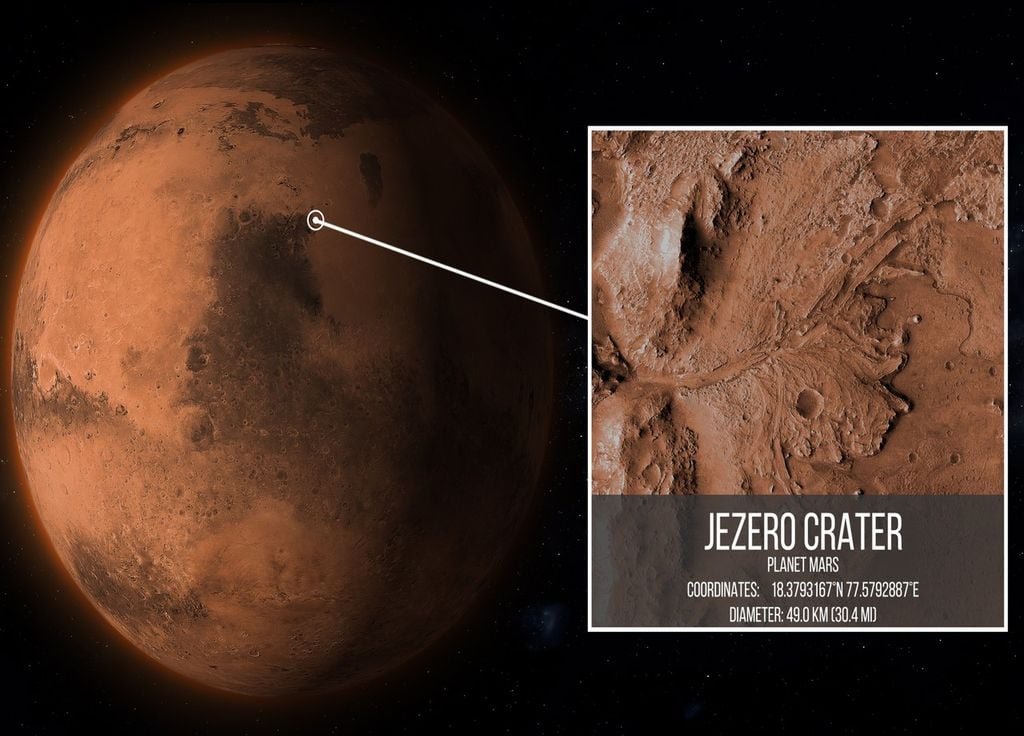
According to the analyzes of several orbital probes and the Rover Perseverance, scientists think thatE Crater Jezero was able to simultaneously house a lake and a volcano About 3 billion years ago, a combination that could have promote the appearance of life in this place.
A very interesting crater
The Perseverance rover has been traveling the Jezero crater since its arrival on the red planet in 2021, in order to learn more about the history of Mars but also of TRemove potential traces of an ancient life.
This crater, formed approximately 3.7 billion years ago by a meteorotic impact had not been chosen at random by the scientists in charge of the Perseverance mission. Indeed, previous studies had revealed that he would have once housed a lake, fueled by a river, which had also been quickly confirmed by Perseverance.
In addition to an old lake, geological training has intrigued researchers for many years. Indeed, a rocky mountain is also present near this crater and, thanks to the data harvested on the ground by Perseverance, the scientists have noticed that Some rocks located at the bottom of Jezero were of volcanic origin.
March as if you were there!
The Rover Perseverance, a faithful Martian explorer of NASA, offers us a 360 ° view of the Jezero crater, an old lake.
A fascinating landscape, made up of rocks, sand and silence where each detail tells the history of a planet pic.twitter.com/zIDFCdTPTS
— Fascinations (@fascinations_sp) December 10, 2024
Thus, by connecting the different data harvested on the ground by Perseverance but also since space by the Mars Odyssey Orbiter, Mars Recognition Orbiter and Exomars Traces Gas, it was concluded that These volcanic rocks could well come from this famous Mont Rocheuxwhich presents the characteristics of an explosive volcano of the stratovolcano type.
A major candidate in the search for an ancient life on Mars?
The proximity of these two structures, a lake and a volcano, makes Jezero’s crater even more attractive that it was not until today for scientists. Indeed, volcanic activity could have generated A hydrothermal activity in the lake once present in the crater, which can promote the appearance of life.
Indeed, the combination of water and volcanic activity can bring together the elements necessary for the appearance of a form of lifeeven in fairly extreme conditions, in a similar way to what we can observe on earth at the bottom of the oceans where Real ecosystems have been formed several kilometers deep near Hydrothermal sources.
Because, if in life needs water, a condition that has been fulfilled to Mars in a distant past, it also needsA sustainable and stable heat sourcewhich could have been brought by the stratovolcana located near the Jezero crater. In addition, a volcanic context also provides Nutrients essential to any metabolic life.
So, Many elements suggest that life could have developed in a distant past in this famous Jezero crater. If no formal evidence of trace of life has yet been found in this lake, perhaps the samples collected as the Rover Perseverance will finally bring a clear and definitive response when they return to earth.
Article reference:
March: What a NASA rover has just discovered could change everything about the search for life, Futura-Science (06/16/2025), Morgane Gillard

